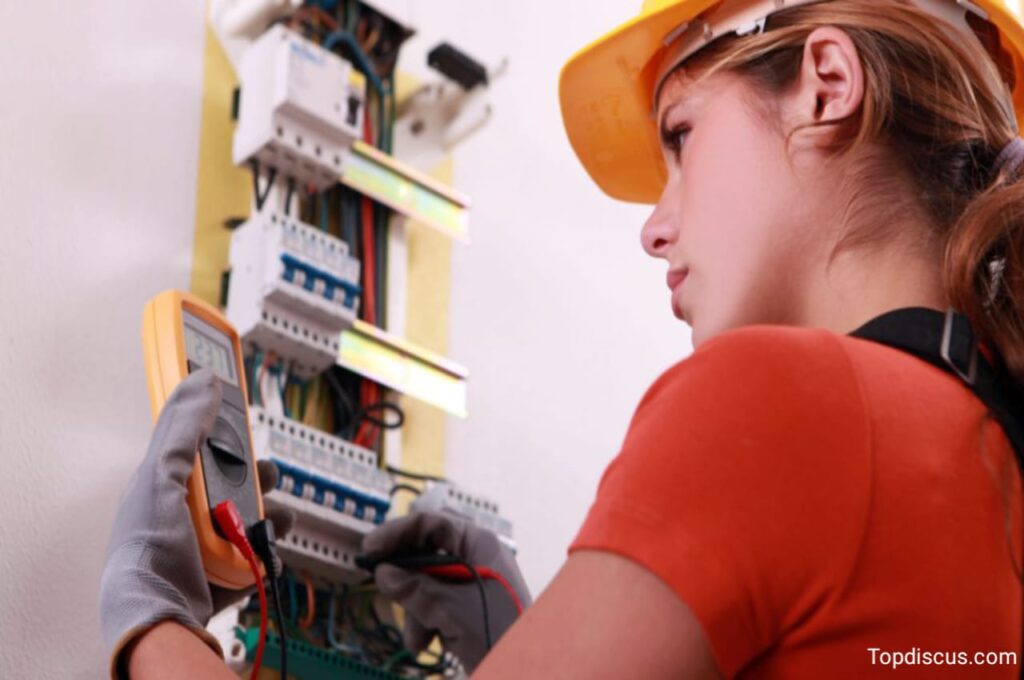If you are a young person about to leave school and are unsure about what career path to choose, becoming an electrician may be a great option for you. While many people might be encouraged to go to university, it’s important to realize that a career in the trades offers plenty of potential and job security. Whether you choose to become an electrician, plumber, or carpenter, there is always work available and the opportunity to earn a good income.
Becoming an Electrician as a Young Person:
 If you are a young person just starting, an apprenticeship is often the best route to becoming an electrician. An apprenticeship allows you to work and learn at the same time, giving you practical experience and theoretical knowledge. Unlike college, where you are only focused on learning without earning, an apprenticeship allows you to earn a wage while developing your skills.
If you are a young person just starting, an apprenticeship is often the best route to becoming an electrician. An apprenticeship allows you to work and learn at the same time, giving you practical experience and theoretical knowledge. Unlike college, where you are only focused on learning without earning, an apprenticeship allows you to earn a wage while developing your skills.
During an apprenticeship, you typically spend one day a week in college and the rest of the week working with a qualified electrician. This hands-on experience allows you to apply the theory you learn in college and gain valuable skills in real-world situations. An apprenticeship usually lasts between three to four years and involves exams and a final practical test called the AM2. Upon completion, you will have the qualifications and experience necessary to work as a qualified electrician.
However, finding an apprenticeship can be challenging due to limited college spaces and high demand. It’s important to stand out to increase your chances of securing an apprenticeship. Additionally, being a good apprentice is crucial to keep your employer’s trust and investment in your future.
Transitioning to a Career in Electrical Work:
 If you are older and considering a career change, there are two main routes you can take to become an electrician. The first option is to enroll in a short course. These courses usually span around 30 days and aim to provide you with the necessary knowledge to pass exams and become a qualified electrician on paper. However, it’s important to note that becoming a skilled and competent electrician takes years of hard work and practical experience. While a short course may give you the qualifications, it’s unlikely that you will be ready to work independently without further practical experience.
If you are older and considering a career change, there are two main routes you can take to become an electrician. The first option is to enroll in a short course. These courses usually span around 30 days and aim to provide you with the necessary knowledge to pass exams and become a qualified electrician on paper. However, it’s important to note that becoming a skilled and competent electrician takes years of hard work and practical experience. While a short course may give you the qualifications, it’s unlikely that you will be ready to work independently without further practical experience.
The second option is to attend night school while working your current job. This route takes longer, usually around two years, but allows you to gain theoretical knowledge while still earning a living. By slowly absorbing the information and gaining practical experience over time, you can develop a strong foundation and understanding of electrical work. This approach may take longer, but it ensures a more comprehensive and well-rounded education.
No matter which path you choose, gaining practical experience is crucial. Even if you have to work for free for a while to gain experience, it will pay off in the long run. By working with a reputable company and receiving proper training and guidance, you can acquire the skills, knowledge, and experience needed to excel as an electrician.
Improving Electrical Installations with Expert Techniques:
When it comes to electrical installations, there are always opportunities to make improvements. In this blog, we will explore the process of installing a garage electrical system and discuss the steps taken to enhance its safety and functionality. From upgrading sockets to installing conduit and swapping out materials, every detail matters. Join us as we delve into the world of electrical installations and discover the expert techniques that can transform any project.
-
Enhancing Safety and Durability
-
Installation of Conduit
-
Adding Extra Power Outlets
-
Installing Baton Lights
-
Swapping to Metal Materials
-
Ensuring Proper Earthing
-
Ensuring Level Installations
-
The Importance of High-Quality Tools
-
Putting Safety First
1. Enhancing Safety and Durability:
One of the first steps in improving the garage electrical system is to replace the existing sockets. In this particular project, the customer requested sturdier sockets with a more modern appearance. By fitting metal MK sockets, the durability and aesthetics of the garage were instantly enhanced.
2. Installation of Conduit:
In addition to upgrading the sockets, the installation of conduit was also necessary. The conduit serves as a protective cover for the electrical wiring, ensuring that it remains safe and secure. By running conduit and concealing the wiring, the overall appearance of the garage is improved and potential hazards are minimized.
3. Adding Extra Power Outlets:
To meet the customer’s needs, an additional power outlet was installed in a convenient location. This involved running conduit up into the roof and connecting it to a new socket. By providing easy access to power, the customer can now use their garage for a variety of purposes without any inconvenience.
4. Installing Baton Lights:
To improve the lighting in the garage, two baton lights were installed. These lights not only provide ample illumination but also add a touch of style to the space. By strategically placing the lights, the entire garage is well-lit, making it easier for the customer to navigate and work in the area.
5. Swapping to Metal Materials:
Another important improvement made to the garage electrical system was the swapping of materials. By replacing certain components with metal alternatives, the system becomes more robust and durable. Metal materials can withstand harsh conditions and are less prone to damage, ensuring the longevity of the electrical installation.
6. Ensuring Proper Earthing:
During the installation process, it was noted that the armoring of the cables was not properly earthed. To rectify this, a whisker box was added to ensure the armoring was grounded correctly. By addressing this issue, the safety of the electrical system is significantly improved, mitigating the risk of electrical faults.
7. Ensuring Level Installations:
When it comes to installing light fittings, achieving a level position is crucial. In this project, it was necessary to correct the position of a light fitting that was touching the brickwork. By making the necessary adjustments, the light fitting now sits perfectly level, enhancing the overall appearance of the garage.
8. The Importance of High-Quality Tools:
Throughout the installation process, the use of high-quality tools is essential. From reliable screwdrivers to accurate spirit levels, having the right tools can make a significant difference in the outcome of the project. Investing in top-quality equipment ensures that every task is completed efficiently and to the highest standard.
9. Putting Safety First:
When working on electrical installations, safety should always be a top priority. The use of proper safety measures such as RCDs and double pole switches is crucial to protect both the electricians and the occupants of the building. By ensuring that all connections are properly isolated and protected, potential hazards can be minimized.
Conclusion:
Improving electrical installations requires attention to detail, expertise, and the use of high-quality materials. By upgrading sockets, installing conduits, and swapping out materials, the overall safety and functionality of a system can be greatly enhanced. With a focus on proper earthing, level installations, and the use of reliable tools, every electrical project can be transformed into a high-quality installation.
 If you are a young person just starting, an apprenticeship is often the best route to becoming an electrician. An apprenticeship allows you to work and learn at the same time, giving you practical experience and theoretical knowledge. Unlike college, where you are only focused on learning without earning, an apprenticeship allows you to earn a wage while developing your skills.
If you are a young person just starting, an apprenticeship is often the best route to becoming an electrician. An apprenticeship allows you to work and learn at the same time, giving you practical experience and theoretical knowledge. Unlike college, where you are only focused on learning without earning, an apprenticeship allows you to earn a wage while developing your skills. If you are older and considering a career change, there are two main routes you can take to become an electrician. The first option is to enroll in a short course. These courses usually span around 30 days and aim to provide you with the necessary knowledge to pass exams and become a qualified electrician on paper. However, it’s important to note that becoming a skilled and competent electrician takes years of hard work and practical experience. While a short course may give you the qualifications, it’s unlikely that you will be ready to work independently without further practical experience.
If you are older and considering a career change, there are two main routes you can take to become an electrician. The first option is to enroll in a short course. These courses usually span around 30 days and aim to provide you with the necessary knowledge to pass exams and become a qualified electrician on paper. However, it’s important to note that becoming a skilled and competent electrician takes years of hard work and practical experience. While a short course may give you the qualifications, it’s unlikely that you will be ready to work independently without further practical experience.